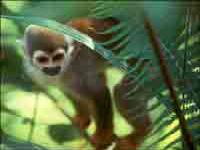
The Amazon or jungle region, located to the east of
the Andes, is one of the most accessible and traveler-friendly areas of
the upper Amazon basin, the biologically richest area anywhere on earth.
There are innumerable varieties of flora, including many of Ecuador's
4,500 species of orchids, and many plants with medicinal value. Wildlife
such as butterflies, bats, monkeys, sloths, parrots, macaws, river
dolphins and caimans are all relatively easy to view.
The Ecuadorian Amazon offers a wide range of
activities including swimming, canoe journeys, rain forest walks, bird
watching, animal spotting and visits to local jungle communities. The
Amazon accounts for little more than 5% of the total population but here
there are small communities of Indians such as the Huaorani, Cofan,
Shuar, and Siona-Secoya who live in jungle villages and carry on with
many of their ancient traditions. The Amazon also has some of the finest
white water rafting routes in the country.
Ecuador's Amazon region can be divided into three
zones:
The provinces of Sucumbios, Orellana and Napo make up a northern zone.
The major city is Nueva Loja or Lago Agrio. Lago Agrio is the capital of
Sucumbíos and the epicenter of the oil exploitation industry. With a
wide array of hotels, restaurants and businesses, it is a dynamic,
commercial town with a frontier-like feeling.
 Another important city of the northern zone is Francisco de Orellana or
Coca. Coca is located at the confluence of the Napo and Coca rivers.
Historically, this small city carries the name of the discoverer of the
Amazon river. The indigenous people native to the surrounding areas, the
Tagaieris or Sachas, know it as Coca because historically they went to
this site to carry out their curative rituals with chewed up coca
leaves. Francisco de Orellana reflects the diversity of Ecuador in its
streets filled with businesses from everywhere. Other important cities
in this zone are Tena and Baeza. Another important city of the northern zone is Francisco de Orellana or
Coca. Coca is located at the confluence of the Napo and Coca rivers.
Historically, this small city carries the name of the discoverer of the
Amazon river. The indigenous people native to the surrounding areas, the
Tagaieris or Sachas, know it as Coca because historically they went to
this site to carry out their curative rituals with chewed up coca
leaves. Francisco de Orellana reflects the diversity of Ecuador in its
streets filled with businesses from everywhere. Other important cities
in this zone are Tena and Baeza.
The central zone is made up by the Pastaza plains, the Pastaza river
and its tributaries. The main city is Puyo. Puyo is located just 100
kilometers from Ambato in the Andes. The town is trying to become a
magnet for tourism, hoping to attract the many tourists who visit the
relatively nearby town of Baños. As part of its cultural tradition,
there are weekly fairs where you can appreciate the customs of the
locals. To complete the atmosphere, there are handicrafts and other
samples of the indigenous cultures of: Shuar, Achuar, Huaorani and Alama.
 The southern zone is made up by the province of Morona Santiago. In the
valley of the Rio Upano lies the city of Macas, the main city of this
region. Macas is known for the church of the Purist Virgin that stands
in its central plaza. A bit farther south, at the confluence of the
Zamora and Bombuscara rivers, is the developing city of Zamora. Zamora
is surrounded by a variety of flora and fauna, including tapirs,
capybaras, agoutis, pumas, birds and insects. It is known as the mining
capital of the country and is home to the gold mines of Nambija,
Chinapinza and Guayzimi. The southern zone is made up by the province of Morona Santiago. In the
valley of the Rio Upano lies the city of Macas, the main city of this
region. Macas is known for the church of the Purist Virgin that stands
in its central plaza. A bit farther south, at the confluence of the
Zamora and Bombuscara rivers, is the developing city of Zamora. Zamora
is surrounded by a variety of flora and fauna, including tapirs,
capybaras, agoutis, pumas, birds and insects. It is known as the mining
capital of the country and is home to the gold mines of Nambija,
Chinapinza and Guayzimi. |